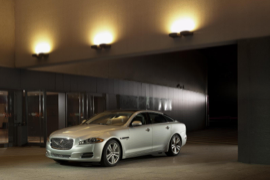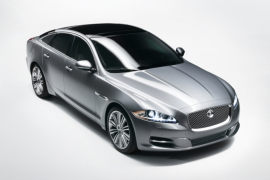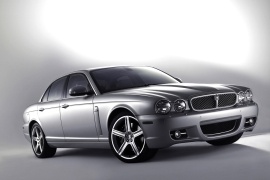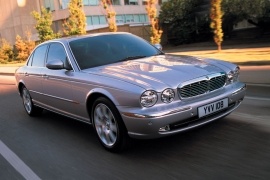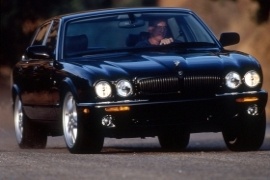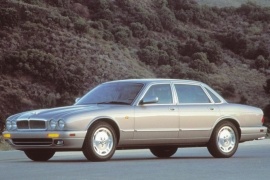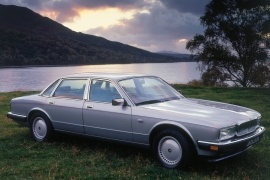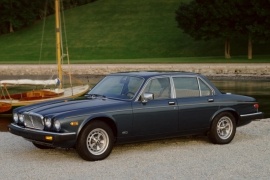JAGUAR XJ Models/Series Timeline, Specifications & Photos
First production year: 1979
Engines: Gasoline, Diesel
While the design of the fourth generation of the XJ started in 2005, under Ford management, the model was launched in 2009 under the new, Tata Motors management. It was renewed in 2012.
The Jaguar XJ didn't face too many generations. The first XJ was launched in 1968 and it was refreshed several times. It was the same situation with the following generations so, the British company decided to do the same with the fourth model. But it had to be refreshed and had to receive new engines to comply with the Euro 6 pollution norms.
From the outside, the car didn't receive obvious changes. The standard version received a set of 19” light-alloy wheels. The heated windshield was available from the 2009 model, but it became standard for the 2012 facelift. A full-length panoramic glass roof was installed to offer an additional sense of spaciousness. Like the 2009 model, the 2012 facelift was available in standard or long-wheelbase versions.
Inside, there were more changes. A full digital 12.3” instrument cluster was included and more comfort features were included in the long-wheelbase package. The 8” dual-view infotainment screen was fitted as standard for all the range.
Under the skin, the 2012 XJ received more aluminum components, making the car lighter than before. The standard transmission was an 8-speed automatic, replacing the older gearbox that brought a lot of complaints in terms of reliability.
Jaguar launched the utterly new XJ in 2009 after Ford sold the British brand to the Indian company Tata Group in 2008.
Ford asked Jaguar to start working on a new flagship model in 2005 under the supervision of Ian Callum as a lead designer. The result was a complete departure from the Jaguar's XJ classic lines. Moreover, the result was more of a sport-executive sedan than just another premium on the market. It resembled the British brand's motorsport origins.
With its shape that resembled more of a four-door coupe than a luxury car, the XJ featured a bold front fascia with a silver mesh grille. Its cat-like headlights swept back and underlined with eight LEDs on each side as daytime running lights, the carmaker's flagship. The XJ showed a front fascia more appropriate for a GT vehicle with its lower apron enhanced by a center grille and two side-scoops. Its profile revealed a long, sloped-down rear windscreen and narrow side windows, while the short trunk lid was flanked by the vertical taillights and adorned by the brand's flying Jaguar.
Inside, Ian Callum sought its inspiration from luxury boats with a run-around wood veneer that emerged from the door cards to the upper side of the dashboard. Its front bucket seats were designed more for comfort but with enough side bolstering. Between them, a tall center console sported the rotary dial for the gear selector. The bench offered enough comfort for two passengers at the back, but the tall transmission tunnel limited the legroom for a third person.
Under the hood, the carmaker installed a range of gasoline and turbo-diesel engines carried over from the XF range. At the launch, it was available with the 3.0-liter V-6 oil-burner and the 5.0-liter V-8 powerplants. Later on, the carmaker extended the range.
JAGUAR XJ 2.0L LWB 8AT (240 HP)
JAGUAR XJ 2.0L SWB 8AT (240 HP)
JAGUAR XJ 3.0L V6 LWB 8AT (340 HP)
JAGUAR XJ 3.0L V6 LWB 8AT AWD (340 HP)
JAGUAR XJ 3.0L V6 SWB 8AT (340 HP)
JAGUAR XJ 3.0L V6 SWB 8AT AWD (340 HP)
JAGUAR XJ 5.0L V8 LWB 6AT (385 HP)
JAGUAR XJ 5.0L V8 Supercharged LWB 6AT (510 HP)
A powerful, luxurious large sedan, the Jaguar XJ was the most technologically advanced vehicle produced by the British company at the time.
As the 3rd generation started to become dated, the XJ was redesigned and improved for the 2008 year model.
While the exterior design was slightly redefined, it still shared many of its lines with he previous models, staying true to its roots.
Roomier than the previous version, the XJ had the same luxurious cabin with wood trims, leather and chrome inserts.
The 2008 model came in five different versions: base XJ8, Xj8 L (long wheelbase), XJR, Vanden Plas and Super V8.
Both the XJ8 and the XJ8 L came with standard 18-inch alloys, active damping suspension, xenon headlamps, a moonroof, full power accessories, Bluetooth connectivity and the Computer Active Technology.
The XJR was not available with an extended wheelbase and featured 19-inch alloys, a different brake system, adaptive cruise control, a tweaked suspension, a navigation system and power-folding side mirrors.
Stepping up to the Vanden Plas, the vehicle was equipped with a heated steering wheel, a navigation system, picnic trays for the rear cabin, power-folding exterior mirrors and a premium audio system.
Moving up to the top-of-the-range, the Super V8 was, of course, equipped with a V8 engine that cranked out 400 hp. Other features included most of the equipment available with the other trim levels and added a rear DVD multimedia entertainment system and a 4-zone climate control system.
The 2003 XJ was more of an evolution rather than a revolution in terms of design for Jaguar's flagship model, but in terms of technology, it was an important leap forward.
While it was already under Ford's umbrella, Jaguar received approval for creating a bold statement on the premium segment with the XJ. The British brand unveiled it at the 2002 Paris Motor Show with unpainted bodywork so that everyone could see that it was made from aluminum.
Jaguar knew that most premium cars already followed a new design trend, where the dual round headlights were considered obsolete, but it just didn't care. Following the same principles of its classic design, the XJ kept the low-roof attitude, even though it affected the occupants' headroom. The slightly sloped-down trunk lid was also a traditional Jaguar line. To simplify things, it kept the taillights exclusively on the quarter panel, so the carmaker could comply with U.S. regulations.
Despite its luxurious interior, with leather or wool upholstery, the cramped headroom made it impossible to sell to taller people. Apart from that, on the center stack, the carmaker had to rely on Ford-sourced equipment, including several buttons and switches. Those plastic knobs didn't match the real wood trims on the door cards and the center console.
Under the hood, the carmaker installed a choice of five engines ranging between 240 hp and 400 hp, the latter being for the XJ-R version. A turbodiesel engine developed together with PSA was also available.
Jaguar introduced a completely new XJ model in 1997, marking a solid comeback on the luxury sedan market.
When Ford bought Jaguar in 1990, it found a great car manufacturer in a bad financial shape. The Coventry-based carmaker had only old models, such as the XJS and the XJ flagship, which were not so young and appealing anymore. Moreover, its engines were outdated, and there was a risk they won't get the Euro 3 emission test approval. So Ford stepped in and pumped the money needed to improve the lineup. In 1996, the British carmaker replaced the 25 years-old XJS with the XK and, in the following year, at the Frankfurt Motor Show, it revealed the XJ8.
While the car was based on the same 1985 XJ40 platform, it featured a completely new design. Its quad, round headlights in individual clusters and the split-grille at the front made a clear distinction over its competitors. By 1997, none of its competitors made round headlights anymore. Another sign of recognition was the low greenhouse and the sloped-down trunk lid.
Inside, the carmaker installed a luxurious, hand-crafted interior with wood veneers and expensive leather. The instrument panel displayed three separate clusters for the speedometer, tachometer, and a third one for the coolant temperature and fuel level. On the center stack, the carmaker installed a new sound system carried over from Ford, while the center console hosted the gear-lever for the automatic transmission. But unlike its main competitors, the XJ didn't provide too much room for the rear seat occupants.
Under the hood, Jaguar installed its new V-8 engines introduced on the XK8. It paired it with a five-speed automatic gearbox provided by ZF.
Jaguar made another step forward for its flagship limousine, the XJ, in 1994 when it unveiled the X300 project. While it was instantly recognizable as an XJ, it featured an updated design where the difference was in the details.
The car was a hybrid development between Ford's demands and British engineering. While it had to stick with some mandatory parts developed by its new owner, Jaguar could use its older inline-six and V12 engines, along with the independent rear suspension.
When Geoff Lawson penned the vehicle in 1991, he had to comply with the carmaker's design language and carried over the cues from the previous XJ, code-named XJ40. He created a similar flat hood with a small bulge in the middle, symbolizing the longitudinally-mounted engine. One big change was for the headlights, which didn't share the same cluster anymore. Moreover, unlike its predecessor, it was not available with rectangular headlamps. Another important change was for the bumper, which was not metallic. But the designer managed to preserve the short greenhouse, just enough to host passengers inside without a tall hat.
The cabin offered room for four passengers with a big center console separating the front seats. Depending on the options, the seats were covered with wool or leather, and the wood trims were present on the door panels, dashboard, center console, and surrounding rear climate control vents. Yet, the headroom was not big enough for anyone taller than the average, and the legroom was good only in the long-wheelbase version of the XJ.
Under the hood, Jaguar installed its 3.2-liter, 4.0-liter inline-sixes, while the range-topper featured a 6.0-liter V12. This generation was built upon a new platform, named XJ81.
Jaguar finally decided to replace its aging first-generation XJ, which has been in production for almost two decades since 1968.
Even though its predecessor's career was divided into three series, those were mostly upgrades on the original 1968 model. But the 1986 XJ was a completely new chapter. Its development began in the early '70s, but due to the 1973 oil crisis, the XJ40 project was delayed. Then, the second oil crisis happened, and the project was postponed again until 1986, when it was finally unveiled.
Initially, the British carmaker tried to have the car designed by Pininfarina, but due to development costs, it turned the Italian car design studio down and penned-it in-house. That led to more of an evolution than a revolution in the vehicle's look. It still sported the same low greenhouse and a svelte silhouette. At the front, depending on the market and trim level, Jaguar installed either a pair of rectangular headlights or twin round lamps that were flanking the chromed grille between them. The car's profile showed an arched beltline that descended towards the rear end.
Inside, Jaguar installed its best interior and granted the car access to its best materials in the storage. Strangely, even though it was its flagship model, it featured wool upholstery for the base trim levels, while leather upholstery was offered as an option. The low seating position was similar to the one in a sports car. Yet, the rear passengers' headroom was enough only for shorter adults or children. There was not enough legroom either, and that's why Jaguar also introduced a long-wheelbase version for the XJ.
Under the hood, the carmaker installed either inline-six or V12 powerplants mated with a five-speed manual or a four-speed automatic. Power went to the rear wheels only.
In 1979, Jaguar introduced a heavily facelifted version of the XJ lineup with the so-called Series III model. It was the most successful version of the XJ's first generation, which lasted until 1992.
Jaguar was way too conservative to create new vehicles, especially if those it had on the production lines were sold in good numbers. For instance, the Series III was the most produced version of it, with total sales exceeding 140,000 units.
While it still kept the original design language, it was slightly reshaped by the magic touch of Pininfarina's artistic touches. Its four headlights were neatly followed on the hood by sculptured lines and rounded shapes. A chromed grille stood proud in the middle, while the "jumping cat" was placed rearwards to protect pedestrians. Yet some countries have already debated that element and considered it dangerous. From its sides, the car sported new, flush door handles, but the overall shape was still fluid. Moreover, Jaguar produced the car with a choice of two wheelbases. The longer one was considered an exclusive limo, just a stint below the renowned Rolls-Royce.
With a pair of bucket seats at the front separated by a center console, which sported an armrest, the XJ provided a great deal of comfort for all passengers. Regardless if it was an automatic or a three-pedal car, the gear stick/selector was placed on the center console. At the back, the bench was profiled for two occupants, with a folding center armrest in the middle.
Under the hood, Jaguar offered the XJ with a choice of three engines, all fed by gasoline. The top-of-the-range version featured a Lucas fuel injection system.
